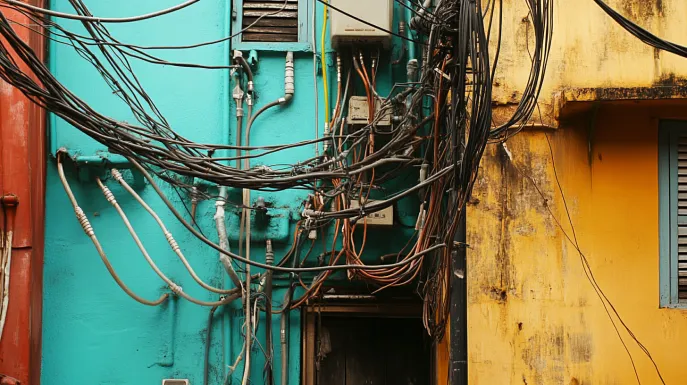Table of Contents
Quality Service Guarantee Or Painting Free

Get a rental agreement with doorstep delivery

Find the BEST deals and get unbelievable DISCOUNTS directly from builders!

5-Star rated painters, premium paints and services at the BEST PRICES!
Loved what you read? Share it with others!

Wire Colour Code in India: Electrical Safety Simplified
Table of Contents
Wire colour code in India is a fundamental aspect of electrical systems, providing a visual language to identify wires in various installations. This simple yet crucial concept enhances safety and standardisation, making it vital for Indian homeowners, electricians, and students alike.
In India, electrical wires follow a specific colour code system, each colour indicating its function. Understanding these codes is paramount as it enhances safety, minimises errors, and ensures consistency. The relevance of wire colour codes is clear - they prevent accidents, aid troubleshooting, and maintain uniformity across electrical systems.
In a country with diverse electrical setups, from traditional homes to modern buildings, grasping these codes ensures safe electrical handling. In this blog, let's explore the world of wire colour codes in India for a safer and more efficient electrical experience.
Quality Service Guarantee Or Painting Free

Get a rental agreement with doorstep delivery

Find the BEST deals and get unbelievable DISCOUNTS directly from builders!

5-Star rated painters, premium paints and services at the BEST PRICES!
Historical Context and Indian Standards

The Evolution of Wire Colour Coding in India
The practice of colour-coding electrical wires has been a critical aspect of electrical safety and efficiency in India for several decades. Initially, the colour coding system was informal and varied among different regions and electricians. This inconsistency often led to confusion and potential safety hazards, especially during maintenance or when modifications were required in electrical systems. Recognising the need for standardisation, Indian authorities began to establish a uniform colour coding system, influenced both by international practices and the unique requirements of the Indian electrical infrastructure.
In the early days, the colour coding was quite basic, primarily using common colours like red for live wires and black for neutral. As the complexity of electrical systems increased, so did the necessity for a more comprehensive and standardised colour coding system. This evolution has been a response not only to technological advancements but also to the increasing awareness about electrical safety.
The Role of the Bureau of Indian Standards (BIS)
The Bureau of Indian Standards (BIS), as the national standard body of India, has been instrumental in establishing and maintaining the wire colour codes used in the country. Formed under the BIS Act of 1986, the BIS took over from the Indian Standards Institution (ISI) and set about creating a unified and safe approach to electrical wiring across India. Their guidelines are not mere suggestions but are key to ensuring safety in electrical installations.
The BIS's colour coding standards are aligned with international norms while catering to the specific requirements of the Indian electrical system. By standardising these colour codes, the BIS has simplified the understanding and handling of electrical wires for professionals and laypeople alike. Their efforts have significantly reduced risks associated with electrical work, such as incorrect wire connections and the hazards they pose.
Regular updates and revisions by the BIS keep Indian standards in line with global practices, reflecting a commitment to continuous improvement and safety in the evolving field of electrical technology. The BIS's role is pivotal in ensuring that the Indian electrical industry remains both safe and efficient.
The Basics of Wire Colour Coding

Wire colour coding is a fundamental aspect of electrical systems in India, providing a visual language to identify and understand the various wires used in electrical installations. Let's break down this concept in straightforward terms to grasp its significance in ensuring safety and standardisation.
Understanding Wire Colour Coding
Purposeful Colour System: In India, electrical wires adhere to a specific colour code system, helping to distinguish between different types of wires based on their functions.
Visual Identification: Each wire in the circuit is assigned a unique colour, making it easier to visually identify its role. This includes live wires (phase), neutral wires, and ground wires.
Simplified Connection: By following a colour code, electricians and individuals working with electrical systems can make accurate connections, minimising the risk of errors or hazardous situations.
Importance of Wire Colour Codes
1. Enhanced Safety: The primary purpose of wire colour coding is to enhance safety. By instantly recognising the type of wire, individuals can take appropriate precautions, reducing the risk of accidents and electrocution.
2. Standardisation for Consistency: Wire colour codes in India adhere to standards set by the Bureau of Indian Standards (BIS). This standardisation ensures consistency across different electrical systems, making it easier for everyone to understand, maintain, and troubleshoot.
3. Accurate Troubleshooting: In case of electrical issues, the colour-coded system allows for quicker and more accurate troubleshooting. Identifying the right wire becomes a simpler task, saving time and effort in resolving problems.
Standard Wire Colours in India and Their Meaning

Understanding the wire colours in the electrical system is crucial for anyone dealing with wiring in India. Let's delve into the standard wire colours and decode their meanings to make electrical installations more accessible and safer for everyone.
Red: Phase or Live Wire
- Function: The red wire signifies the phase in an electrical circuit.
- Live Wire: It carries the electrical current from the power source to the appliances or loads.
- Usage: Typically used in single-phase electrical installations.
- Safety Note: Avoid connecting red wires to each other or to black wires to prevent electrical hazards.
Black: Neutral Wire Colour in India
- Function: The black wire represents the neutral wire in an electrical circuit.
- Returning Current: It carries the returning current from electrical appliances back to the power source.
- Usage: Connect black wires to black wires only; it primarily handles the unbalanced load.
- Safety Note: While neutral, it still carries current, so handle it with care.
Green: Earthing wire colour in India
- Function: The green wire serves as the grounding or earthing wire in an electrical circuit.
- Path to Ground: In the event of a fault or short circuit, it provides a safe path for electrical current to reach the ground.
- Usage: Connect green wires to green wires only, typically used for sockets (AC, geyser, TV, etc.).
- Safety Note: Handle with care, as during a fault, the green wire could carry a significant current.
Additional Colours Used in Special Circumstances
While the primary colours are red, black, and green, specific circumstances may require additional colours:
- Brown: Commonly used in three-phase electrical installations for live wires.
- Green with Yellow Stripe: In some instances, a green wire with a yellow stripe may indicate the ground wire.
Safety First: Understanding and Respecting Wire Colours

Why Correct Identification Matters
In the realm of electrical systems, safety is paramount. One of the fundamental aspects of ensuring safety is the correct identification of wire colours. In India, where diverse electrical systems coexist, from ageing infrastructure in historic buildings to modern installations in new constructions, understanding wire colour codes is crucial. Each colour in the wiring serves a specific purpose: Red for the live wire, Black for neutral, and Green for the earth or grounding wire. Misidentifying these can lead to dangerous situations, including electrical shocks, short circuits, or even fires.
For non-professionals, differentiating between these colours is the first step towards the safe handling of any electrical component, be it during simple household tasks or minor DIY electrical projects. Recognising these colours not only helps in identifying the function of each wire but also in understanding the potential risks involved.
Tips for Safe Handling of Electrical Wires
- Power Off: Always ensure the main power supply is switched off before attempting any electrical work. This is the most crucial step in preventing accidents.
- Use Insulated Tools: When working with electrical wires, use tools with insulated handles. This adds an extra layer of protection against accidental shocks.
- Avoid Water: Keep electrical components and your hands dry. Water is a conductor of electricity and increases the risk of electrocution.
- Check Wire Condition: Before handling, inspect wires for any damage or wear. Frayed or exposed wires can be hazardous.
- Don't Rely on Colours Alone: While wire colours are a guide, they should not be the only check for safety, especially in older systems where wiring might not adhere to current standards.
- Consult a Professional: If unsure, it's always safer to consult a professional electrician. Handling electrical wires without proper knowledge can lead to severe consequences.
- Educate Yourself: Familiarise yourself with basic electrical safety guidelines. A little knowledge can go a long way in preventing accidents.
Common Mistakes and Misconceptions

Misconceptions:
Misconceptions and mistakes in handling wire colours can lead to serious safety risks. Here's a straightforward guide to avoid them:
1. "Any Wire Can Serve Any Purpose": This is false. In Indian electrical systems, wire colours are not arbitrary. Red indicates live wires, black for neutral, and green for grounding. Interchanging these can lead to serious hazards.
2. "Older Systems Follow the Same Colour Codes": Many older Indian buildings may not comply with current colour standards. It's crucial to verify the wiring system before any work to avoid safety risks.
3. "DIY Repairs Are Always Safe If I Follow the Colour Code": Even with correct colour knowledge, electrical work requires expertise. Mishandling can lead to dangerous situations, making professional consultation a safer choice.
4. "A Wire's Colour Never Fades or Changes": Wire colours can fade or get dirty, complicating identification. This is particularly true in areas with high humidity or pollution. Regular checks are advised.
5. "Green Wires Are Not Dangerous": The green wire, used for grounding, is vital for safety, especially in faults or short circuits. It must be treated with the same caution as live wires.
6. "Colour Codes Are the Same Globally": Wire colour codes can differ internationally. Assuming global uniformity can lead to mistakes, especially for those who've encountered different systems.
Common Mistakes:
- Incorrect Wire Connections: Using wires based on availability rather than their function is risky. Each colour-coded wire has a specific purpose.
- Inadequate Joint Insulation: Inadequately insulated wire joints can cause short circuits. Proper insulation is crucial, especially in India's humid climate.
- Overlooking Earthing Requirements: Neglecting the green earth wire can lead to safety issues. Proper connection and use are essential.
- Overloading Circuits: Adding too many devices to a single circuit can cause overheating and fires. It's important to understand the capacity of wires and circuits.
- Confusing Wire Colours Due to Poor Lighting: Misidentifying wire colours in bad lighting can lead to incorrect connections. Always work in well-lit areas and double-check wire identities.
- Ignoring Wire Condition: The condition of a wire is as important as its colour. Using damaged or frayed wires is unsafe, regardless of their correct colour.
Understanding and avoiding these common misconceptions and mistakes is crucial for safely handling electrical wires, particularly in the diverse electrical landscape of India.
Keeping Up with Changes

Adapting to Updated Wire Colour Standards
In India's ever-evolving electrical industry, staying current with the latest wire colour standards is crucial for safety and professionalism. Recent updates may include new colour combinations or revised guidelines for specific wire uses.
The Importance for Professionals
For electricians and industry professionals, being up-to-date is essential to avoid safety risks and ensure compliance. Regularly consulting the Bureau of Indian Standards (BIS) and engaging in ongoing education are key practices for staying informed.
Ensure Electrical Safety with NoBroker Professional Electricians!
Comprehending the wire colour code in India is vital for all involved in electrical systems. The colour system serves a purpose, simplifying connections, boosting safety, and ensuring uniformity. The Bureau of Indian Standards (BIS) plays a key role in maintaining these standards, enhancing safety and efficiency.
We urge readers to prioritise safety by correctly identifying wire colours, using insulated tools, and consulting professionals when in doubt. Electrical safety is paramount; respecting wire colours is the initial step towards a secure electrical environment.
At NoBroker, we prioritise your safety and convenience. Our professional electricians are well-versed in the latest wire colour standards, offering secure and effective electrical services. Don't compromise on safety – opt for NoBroker professional electricians for your electrical needs. Take a safety stride today and book a NoBroker electrician expert TODAY!
Find Trusted Electricians Near You – City-wise
Frequently Asked Questions
Ans: In India, the 3-phase wire colour code includes brown for phase 1, black for phase 2, gray for phase 3, and green with a yellow stripe for grounding.
Ans: The single-phase wire colour code in electrical systems helps identify the live and neutral wires, enhancing safety and ensuring correct connections.
Ans: In electrical wiring, the red wire typically signifies the live or phase wire, black is the neutral wire, and green is the grounding wire. Understanding these colours is essential for safe electrical work.
Ans: In India, the phase wire is typically red, and the neutral wire is black. Understanding these colours is crucial for safe electrical work.
Ans: The cable colour code makes it easier for electricians to make accurate connections and for homeowners to understand their electrical systems, ultimately enhancing safety and efficiency.
Loved what you read? Share it with others!
Most Viewed Articles

Best 10 Switch Brands in India 2026: Top Picks for Smart, Stylish, & Safe Homes
August 25, 2025
97997+ views

Top 10 Wire Companies in India: Founding Year, Valuation, Share Value and More Details in 2026
September 26, 2025
77344+ views

Wire Colour Code in India: Electrical Safety Simplified
January 31, 2025
43859+ views

10 Best Ceiling Fan Brands in India: Features, Price & Warranty in 2026
July 29, 2025
16271+ views

Installing Water Meters in Your Home Society
January 15, 2025
15500+ views
Recent blogs in
V-Guard Vs Polycab Wires: Compare Quality, Safety, Price and Durability
December 18, 2025 by Vivek Mishra
Anchor Vs Havells Wire: Copper Purity, Insulation, Durability & Safety
December 17, 2025 by Ananth
Finolex vs RR Kabel: Safety, Durability, Copper Quality and Price Range
December 17, 2025 by Vivek Mishra
Top 10 Smart Touch Switches Brands in India: Types, Price Range and Warranty
November 18, 2025 by Priyanka Saha
Types of Wiring in a House: Importance, Comparison, Costs and Safety Tips
November 18, 2025 by Priyanka Saha









 Full RM + FRM support
Full RM + FRM support
Join the conversation!